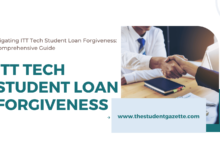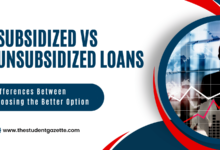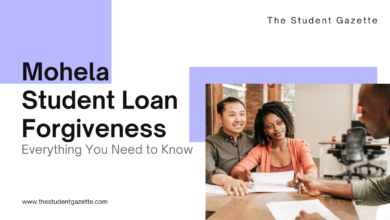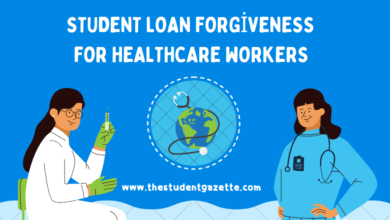Student Loan Forgiveness Application: A Comprehensive Guide

Student loans can burden individuals, hindering financial progress and freedom. However, there are options available to alleviate this burden through student loan forgiveness. This guide provides a comprehensive understanding of student loan forgiveness , eligibility criteria, the student loan forgiveness application process, and other relevant information.
Introduction
Student loan forgiveness is a program designed to relieve borrowers of their debt obligations under certain circumstances. By meeting specific criteria, individuals can have a portion or all of their student loans forgiven, reducing their financial burden and providing a fresh start.
Understanding Student Loan Forgiveness
What is Student Loan Forgiveness?
Student loan forgiveness is a government-initiated program that allows eligible borrowers to have their student loan debt canceled or discharged. The forgiveness is typically granted to those who work in specific fields or fulfill specific requirements, such as working in public service or teaching in low-income schools.
Importance of Student Loan Forgiveness
Student loan forgiveness is crucial in supporting individuals who have pursued higher education and are burdened with substantial debt. It provides a pathway for financial stability, encourages career choices in public service, and enables borrowers to progress toward their long-term financial goals.
Eligibility for Student Loan Forgiveness
Types of Loans Eligible for Forgiveness
Not all student loans are eligible for forgiveness. Typically, federal student loans are the primary focus of forgiveness programs. These may include Direct Loans, Stafford Loans, Perkins Loans, and certain consolidation loans. Private loans, on the other hand, are generally not eligible for forgiveness.
Qualifying Employment
Many student loan forgiveness programs require borrowers to work in specific fields or industries to be eligible. For instance, the Public Service Loan Forgiveness (PSLF) program requires borrowers to work full-time for a qualifying employer, such as a government or nonprofit organization.
Other Eligibility Criteria
In addition to loan types and qualifying employment, there are often other eligibility criteria for student loan forgiveness programs. These may include making a certain number of consecutive on-time payments, meeting income requirements, or fulfilling specific service obligations.
Application Process for Student Loan Forgiveness

The application process for student loan forgiveness typically involves several steps that borrowers must follow diligently. By understanding and adhering to the process, individuals can increase their chances of successfully receiving loan forgiveness. Here are some additional details about the application process:
- Research and Identify Eligible Forgiveness Programs: Before starting the application process, borrowers should identify the forgiveness programs they qualify for. As mentioned earlier, various programs are available, such as Public Service Loan Forgiveness (PSLF), Teacher Loan Forgiveness, Perkins Loan Cancellation, and Closed School Discharge. Each program has specific eligibility criteria and benefits, so it is essential to understand the requirements and choose the program that aligns with your circumstances and career goals.
- Gather Required Documents: Once borrowers have identified the forgiveness program they want to apply for, they should gather all the necessary documentation. The specific documents needed may vary depending on the program, but common requirements include loan statements, employment certification forms, tax records, proof of qualifying employment, and other supporting materials. Having these documents readily available will streamline the application process and help ensure that all required information is provided accurately.
- Complete the Application Form: After gathering the required documents, borrowers must complete the application form for the chosen forgiveness program. It is crucial to carefully read and follow the instructions provided in the application form to ensure accurate and complete submission. Any inaccuracies or omissions can lead to delays or even denial of forgiveness.
- Review and Verify Application Accuracy: Before submitting the application, reviewing and verifying the accuracy of all the information provided is essential. Double-checking the form for errors, missing information, or inconsistencies is crucial to avoid potential complications. It is recommended to seek assistance from a financial aid counselor or loan servicer if you have any doubts or questions regarding the application.
- Submitting the Application: Once the application form has been completed and reviewed, it is time to submit it along with the required supporting documents. The submission process may vary depending on the forgiveness program and the organization administering it. Some programs may require online submissions, while others may accept applications via mail or email. Making copies of all the submitted documents for your records is advisable.
- Monitor the Application Progress: After submitting the application, borrowers should stay in contact with the loan servicer or forgiveness program administrator to monitor the progress of their loan forgiveness application. It is recommended to keep records of any communication, such as email exchanges or reference numbers, for future reference. If there are any delays or issues, contacting the loan servicer or program administrator for updates and clarification is essential.
By following these steps and staying organized throughout the application process, borrowers can increase their chances of a successful student loan forgiveness application. It is important to remain patient as the processing timeframes can vary depending on the forgiveness program and other factors.
How to Apply for Student Loan Forgiveness
Applying for student loan forgiveness involves several steps and careful attention to detail. By following these guidelines, borrowers can navigate the application process successfully.
Gather Necessary Documents
Before applying, it’s essential to gather all the necessary documentation. This may include loan statements, employment certification forms, tax records, and other supporting materials. Having these documents readily available will streamline the application process.
Choose the Right Forgiveness Program
Various forgiveness programs are available, each with its own eligibility requirements and benefits. Understanding the different programs and selecting the one that best aligns with your circumstances and career goals is crucial.
Complete the Application Form
Once the appropriate forgiveness program is selected, the next step is to complete the application form. Pay close attention to the instructions and provide accurate information. Only complete or accurate applications may lead to delays or denial of forgiveness.
Submitting the Application
After completing the application form, carefully review it to ensure accuracy. Gather all the required supporting documents and apply them to the designated channels. Keep copies of all documents for your records.
Common Mistakes to Avoid
When applying for student loan forgiveness, it’s important to avoid common mistakes that could hinder the success of your application.
Inaccurate Information
Ensure that all the information provided in your application is accurate and up-to-date. Double-check the form for any errors or omissions before submitting it.
Missing Deadlines
Each forgiveness program has specific deadlines for application submission. Missing these deadlines may result in delayed or denied forgiveness. Stay informed about the deadlines and submit your application well in advance.
Incomplete Documentation
Please include all the necessary supporting documentation to avoid delays or rejection of your application. Review the requirements carefully and ensure that all documents are included.
When Will Student Loan Forgiveness Be Applied?
The timeframe for processing and approving student loan forgiveness applications varies depending on the program and the application volume.
Processing Timeframes
While some forgiveness programs estimate processing times, it’s important to note that the actual processing time can vary. Application complexity, program funding, and administrative resources can influence the timeline.
Monitoring Loan Forgiveness Progress
After submitting your application, it’s important to monitor the progress of your loan forgiveness. Stay in contact with the loan servicer or forgiveness program administrator to receive updates and ensure that your application is being processed.
Student Loan Relief Application Alternatives

Apart from the formal student loan forgiveness programs, there are other avenues for obtaining relief from student loan debt.
Income-Driven Repayment Plans
Income-driven repayment plans adjust the monthly loan payments based on the borrower’s income and family size. These plans help make the loan payments more manageable by capping the monthly amount you have to pay.
Loan Consolidation
Loan consolidation involves combining multiple loans into one, simplifying the repayment process. This can also lower monthly payments, making them more affordable.
Federal Loan Forgiveness Application Programs
Several federal loan forgiveness programs are available to borrowers, offering relief based on specific criteria.
Public Service Loan Forgiveness (PSLF)
The Public Service Loan Forgiveness (PSLF) program forgives the remaining loan balance for borrowers who have made 120 qualifying payments while working full-time for a qualifying employer in public service.
Teacher Loan Forgiveness
The Teacher Loan Forgiveness program provides loan forgiveness for eligible teachers who have worked in low-income schools or educational service agencies for at least five consecutive years.
Perkins Loan Cancellation
The Perkins Loan Cancellation program forgives a percentage of the loan for borrowers who work in certain public service positions or specific professions, such as teaching, nursing, or law enforcement.
Closed School Discharge
Closed School Discharge offers loan forgiveness for borrowers whose schools closed while enrolled or after they withdrew.
Conclusion
Student loan forgiveness provides a lifeline for borrowers burdened with student debt. By understanding the eligibility criteria, the application process, and alternative options available, borrowers can take steps toward achieving financial freedom and a brighter future.
Frequently Asked Questions (FAQs)
What is the deadline for student loan forgiveness applications?
The deadline for student loan forgiveness applications varies depending on the program. It’s crucial to stay informed about the specific deadlines and submit your application within the designated timeframe.
Can I apply for student loan forgiveness more than once?
Sometimes, it may be possible to apply for student loan forgiveness more than once. However, eligibility criteria and program requirements may differ for subsequent applications.
What happens if my student loan forgiveness application is denied?
Suppose your student loan forgiveness application is denied. In that case, you may have the option to appeal the decision or explore alternative repayment options. Review the reasons for the denial and consult with your loan servicer for guidance.
Will student loan forgiveness cover both federal and private loans?
Generally, student loan forgiveness programs primarily focus on federal student loans. Private loans typically do not qualify for forgiveness. However, exploring refinancing or loan consolidation options may help manage private loan debt.
How long does it take to receive student loan forgiveness?
The processing time for student loan forgiveness applications can vary depending on the program and other factors. It’s important to stay in contact with the loan servicer or forgiveness program administrator to receive updates on the progress of your application.





